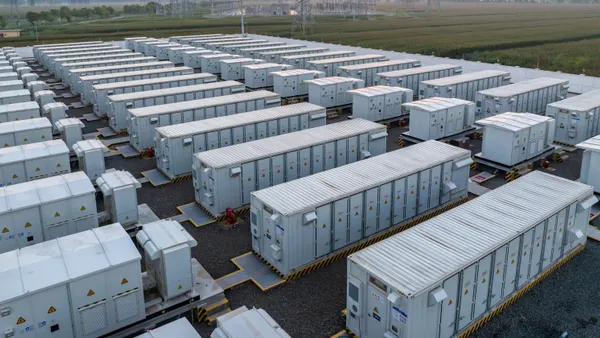Dive Brief:
-
Xcel Energy will deploy two multi-day, iron-air battery systems built by Form Energy, which could support the utility company becoming a renewable energy exporter, company officials announced Thursday.
-
Both projects will be installed at the site of retired coal plants, and should come online by 2025, pending regulatory approval.
-
The company is also looking for opportunities for green hydrogen pilot projects, but currently does not have any green hydrogen included in its five-year plan, officials said during a company earnings call.
Dive Insight:
Xcel Energy customers have benefited significantly from their region’s rich renewable energy resources—and could further capitalize on those resources by exporting energy to other regions, company officials said on an earnings call to discuss 2022 results.
CEO Bob Frenzel told investors the company’s extensive wind resources had saved on the order of $1 billion in the past year as natural gas and fuel prices rose. The company’s geography, he said, provides access to abundant wind and solar resources that could represent a key competitive advantage in the future. And not just on cost. The company is looking at opportunities that could make Xcel Energy an energy exporter, “whether that’s electricity via wire or green hydrogen via pipe or trucking,” Frenzel said.
To that end, he said, the company will begin construction on two 10-MW energy storage systems that will use iron-air batteries made by startup Form Energy.
Iron-air batteries work similarly to lithium ion batteries—you put the energy into the battery, the battery holds the energy, and then you discharge it, Mateo Jaramillo, CEO and co-founder of Form Energy, explained in an interview after the earnings call. But inside the battery the system turns sheets of iron into rust and then back into iron as a means of energy storage.
Iron-air batteries aren’t a new technology, he said. They were studied in the 1970s for potential use in vehicles, but that application didn’t work out. Iron-air batteries are cheaper than today’s lithium mainstays, but they lose more energy to the process of energy storage. This limited their potential use when energy efficiency was paramount.
Enter renewable energy curtailment. Now, Jaramillo said, iron-air batteries begin to make sense. Although some energy is lost in the process, iron-air batteries have the capacity to capture and store energy for multiple days—something that is still too costly with lithium ion technology.
Xcel Energy plans to install the batteries at retired coal plants in Becker, Minnesota, and Pueblo, Colorado, and they won’t be the only utility to deploy iron-air batteries. Jaramillo said Form Energy also has a deal in the works with Georgia Power and several other companies that have yet to make announcements. Form Energy has begun work on a 500-MW manufacturing facility in West Virginia. The company’s first pilot project with Great River Energy is still under construction.
“We have been surprised at how quickly the market has moved,” he said. “The utility industry, broadly speaking, sees [it] can do this transition, and that it’s the right thing for their ratepayers...and that’s the path they’re going down.”
Long-duration batteries aren’t the only potential storage technology Xcel Energy is exploring. Frenzel said the company has a pilot project to use nuclear energy to produce hydrogen and is looking for possible green hydrogen pilot projects, although the company has not identified any near-term hydrogen opportunities.
The company participated in two regional hydrogen hub applications that received positive reviews from the U.S. Department of Energy earlier this year and will continue to collaborate on the next application round due in April. The company does not expect DOE will make a final decision about the hub locations until the end of 2024.
Correction: A previous version of this story had an incorrect location for Form Energy’s 500-MW manufacturing facility. It will be in West Virginia.














